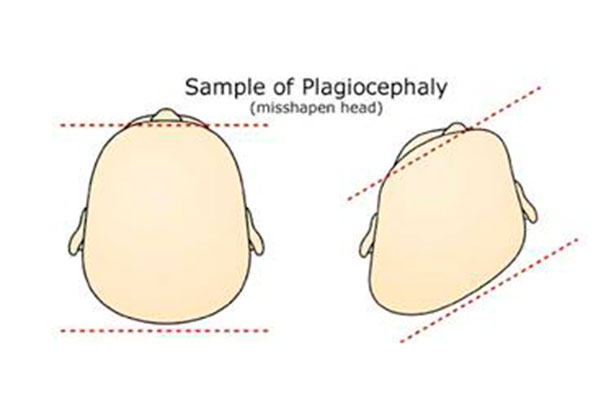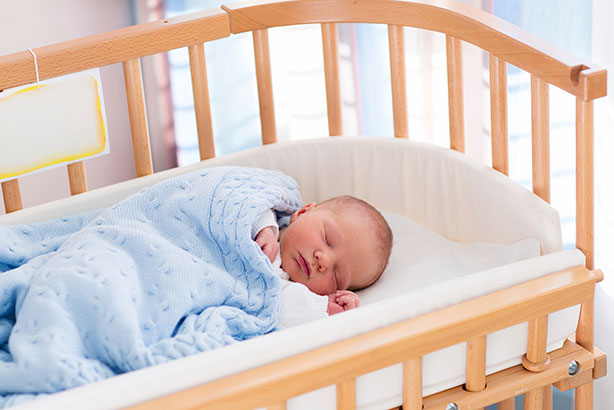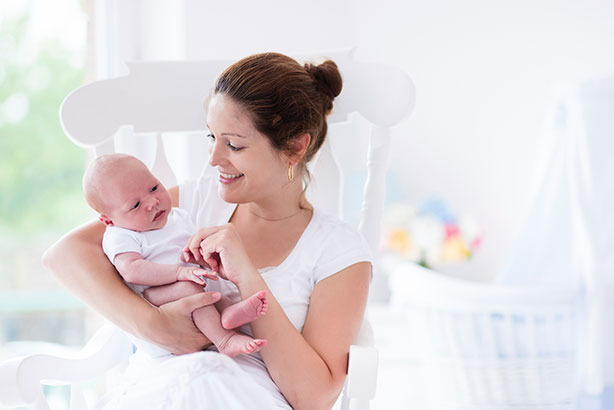What is flat head syndrome?
The official term is 'Plagiocephaly', but how does it happen and how can it be avoided?

Flat head syndrome, or 'Plagiocephaly', is when a baby develops flattened areas on the head due to repeated pressure on soft parts of the skull.
The human skull is made up of plates of bone that fuse together over time, but when a baby is newborn the skull is soft and malleable.
If a child spends too much time lying or sitting in the same position then flat head syndrome can occur due to the repeated pressure on soft areas.
What is flat head syndrome?
The NHS identifies two types of flat head syndrome;
Plagiocephaly – the head is flattened on one side, causing it to look asymmetrical; the ears may be misaligned and the head looks like a parallelogram when seen from above, and sometimes the forehead and face may bulge a little on the flat side.
Brachycephaly – the back of the head becomes flattened, causing the head to widen, and occasionally the forehead bulges out.
How common is flat head syndrome?
The NHS advises that this is fairly common and as many as 1 in 5 babies can experience flat head syndrome.
GoodtoKnow Newsletter
Parenting advice, hot topics, best buys and family finance tips delivered straight to your inbox.
A study in Canada, by the Calgary Mount Royal University, found almost 50% of newborns aged 7-12 weeks had some form of Plagiocephaly.
Why would my child get flat head syndrome?
Usually as a result of them spending a lot of time lying on their back, especially while sleeping.
The back or side of their head can always become flattened as a result of sleeping on their back, but it is important to not place your child on their front in order to reduce the risk of Sudden Infant Death Syndrome (SID).

Image:Babymoov/Lil'Spin PR
Is lying down the only cause of flat head syndrome?
It's not just sleeping that can cause flat head syndrome, it can also be a result of problems in the womb or neck muscle tightness.
Problems in the womb: the pressure of amniotic fluid can cause this to occur before a baby is even born, or if things are a bit squashed in the womb if a mother is carrying twins.
Neck muscle tightness: this can prevent a baby from turning their head a particular way meaning one side of their head is consistently under more pressure than another.
Are premature babies more likely to get flat head syndrome?
The earlier a baby is born, the less time the skull will have had to harden in the womb. Therefore if a baby is born prematurely they have a softer skull and are more prone to developing flat head syndrome.
Is flat head syndrome dangerous?
In most cases flat head syndrome isn't a major cause for concern, as it doesn't have any effect on the brain and head shape will correct itself over time.
You should speak to your health visitor or family GP if you are concerned about the shape of your baby's head or think that they're developing problems with muscle tightness and turning their head.
It's a good idea to get advice as early as possible so steps can be taken to prevent the problem getting worse.
What can I do to prevent flat head syndrome in my baby?
Give them time on their tummy during the day and encourage them to try new positions during playtime, but make sure they always sleep on their back due to the risk of SIDS.
Switch your baby between a sloping chair, a sling and a flat surface as this distributes pressure around different points.
Change the position of toys and mobiles in the cot so that they are encouraged to look around and move their head whilst they are lying on their back in the cot. Strategically place engaging objects behind them and to the side.
You can also try alternating the side you feed and carry your baby and reducing time spent on a flat surface such as car seats and prams by using a sling or front carrier.

Is there more I can do if these techniques aren't working?
These techniques could take a couple of months to make a noticeable difference.
The treatments listed above are the official guidelines provided by the NHS, and while there are other treatments such as helmets and matresses or pillows (see below), there is no conclusive evidence to suggest these are much more effective at treating the problem.
What is the best helmet for flat head syndrome?
Parents can buy specially designed helmets and headbands that reportedly change the shape of a baby's skull as it grows.
If parents decide to pursue helmet treatment, these are not available on the NHS and typically cost around £2000, then treatment is started around five or six months old and the device is worn for up to 23 hours a day.
There is no conclusive evidence to suggest they're any more effective than other simple measures as listed above. They often cause problems such as skin irritation and rashes. They may also be uncomfortable and distressing for the baby.

What other products can I try to prevent flat head syndrome?
Some people try special curved mattresses that are designed to distribute the weight of a baby's head over a larger area so less pressure is placed on a particular point of the skull.
You can also get special pillows, which have ergonomic designs, including holes in the middle or a special rounded shape to support the head on flat surfaces.
There are several styles of pillow, which can be used to support the baby while they are on a flat surface, including;
Lovenest – A pillow that ensures pressure is evenly distributed across the infant's head, thereby helping maintain the natural curvature of the skull. Made from soft, breathable fabrics it is suitable to use from birth in pushchairs, bouncers and cots.
Cosydream pillow – A sleep positioner that keeps babies in the correct support and posture and with a headrest that reduces risk of flat head syndrome.
BabyMoon pillow – This looks like an adult travel pillow, with a curved shape and hole in the middle, it can be moved between prams and cots and it's good for when children are playing on their back.
Trusted, informative, and empathetic – GoodToKnow is the ultimate online destination for parents. At GoodtoKnow, our mission is 'simple': we're trying to make sense of parenthood. On the site, you'll find everything you need for a happy, healthy family life. Our huge archive of content includes more than 18,000 articles and 1,500 how-to videos. These include expert-backed advice features on parenting, dealing with relationship changes after having a baby, self-care for mums and managing your family finances. We also feature tried-and-tested product reviews and buying recommendations for every stage of family life - from prams and Moses baskets to birthday gifts and top toys.